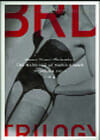
In his 1966 book From Caligari to Hitler, Siegfried Kracauer posited that such early German cinema masterpieces as The Cabinet of Dr. Caligari, M, Metropolis and Nosferatu, with their themes of totalitarianism, bloodlust and madness, presaged the rise of fascism and the horrors of the Third Reich. On its face, such a thesis suggests these directors possessed psychic powers, but not when one considers the tumultuous German political landscape that informed these works. As the Weimar Republic began to wane and the economy collapsed, a nation grew susceptible to the promise of a new, more powerful republic.
Half a century later Germany was still reeling from the ramifications of World War II. The mixture of guilt, anger and confusion, not surprisingly, led to denial. No one was more sensitive to the odd roiling potion of the national consciousness than the wunderkind director Rainer Werner Fassbinder. In the late 1970s he noted, “They can’t have forgotten [the Holocaust]; they must have had it in their minds when they were creating their new state. If a thing of so much significance could be forgotten or repressed, then something must be pretty wrong with this democracy and this ‘German model.’”
So troubled was Fassbinder by this shared selective memory that he created a trilogy of films in response. Known collectively as the BRD (Bundesrepublik Deutschland) Trilogy, The Marriage of Maria Braun, Veronika Voss and Lola portrayed the post-war era through the experiences of three women and offered a deeply human piece of dramatic historiography. Now a four-DVD set brings these three films together with excellent supporting material that adds depth to the context of the films, as well as Fassbinder’s truly unique and self-destructive personality.
The Marriage of Maria Braun (1979) caused an immediate sensation upon its release. Maria, a widowed war bride, is forced to do whatever it takes to navigate the German post-war system. While clearly influenced by his hero, director Douglas Sirk, Fassbinder infuses the film with a gritty feel that is his own. Video interviews with star Hanna Schygulia and Fassbinder scholar Eric Rentschler offer additional insight.
The lustrous black and white cinematography of Veronika Voss (1982) lends resonance to the story of a once popular movie star who goes into an ever-widening spiral of despair. The inclusion of a fascinating one-hour documentary on UFA star Sybille Schmitz, Fassbinder’s inspiration for Voss, provides a deeper look into the film.
Lola (1981), the last film of the trilogy (though the second to be released), was spun as a quasi-remake of von Sternberg’s 1930 classic The Blue Angel. The lush, outrageous colors Fassbinder employed for the film belie its satiric nature. The chanteuse-prostitute Lola uses her charms to manipulate the men around her, all in pursuit of the good life.
With copious interviews, a huge booklet with essays on all the films and a detailed documentary on Fassbinder’s life, the set provides an excellent overview of his place in cinema history. The gorgeous digital transfers make them an even greater pleasure to watch.